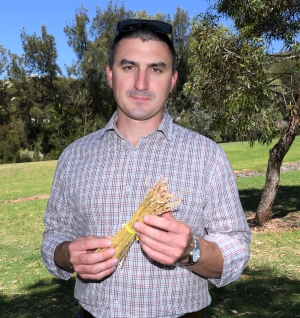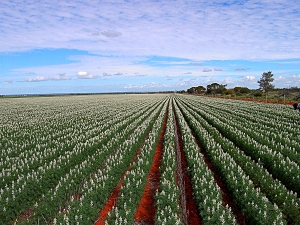Australia
September 4, 2020

SARDI research scientist Blake Gontar says unlike foliar diseases in pulse and oilseed crops, knowledge around root diseases is limited. Photo: GRDC
Researchers are seeking input from grain growers and advisers across Australia as they delve into the nation’s soils to learn more about root diseases in pulse and oilseed crops.
Through a Grains Research and Development Corporation (GRDC) investment, the frequency and distribution of potential soil-borne disease-causing pathogens in pulse and oilseed cropping areas is being investigated.
Until recently, little has been known about the status of soil-borne pathogens in regions where pulses and oilseeds are grown.
However, a national survey is continuing in 2020 across the southern, western and northern growing regions, to build on information generated out of a similar national survey in 2019.
Leading the national initiative is research scientist Blake Gontar from the South Australian Research and Development Institute (SARDI), the research division of Primary Industries and Regions South Australia (PIRSA).
Mr Gontar says unlike foliar diseases in pulse and oilseed crops, knowledge around root diseases is limited.
“The reason we are undertaking this survey work is that we don’t have a good handle on which pathogens exist in areas where pulse and oilseed crops are grown, as well as their frequency and distribution,” Mr Gontar says.
Researchers are keen to receive root samples representative of all pulse and oilseed growing regions, as well as seeking observations and reports from growers and advisers.
Mr Gontar and the SARDI research team are collaborating with pathologists from Agriculture Victoria, the Department of Primary Industries and Regional Development in Western Australia, New South Wales Department of Primary Industries, and the University of Southern Queensland in undertaking the survey.
Pathologists in each state are responsible for disseminating the sampling kits to agronomists and growers and collating and scoring samples from their respective regions.

Through a GRDC investment, the frequency and distribution of potential soil-borne disease-causing pathogens in pulse and oilseed cropping areas is being investigated. Photo: GRDC
Agriculture Victoria research scientist Joshua Fanning says the amount of understanding and knowledge developed out of this survey “is very much dependent on the extent of involvement from growers and advisers”.
“We understand growers and agronomists have been seeing patches in pulse paddocks for several years,” Dr Fanning says. “We hope this new project will help identify what is causing these patches or any other soil-borne diseases in both pulse and canola paddocks.”
Samples from western cropping areas are being collected by DPIRD research officer Carla Wilkinson.
“Samples received by DPIRD will be washed, photographed and rated for damage from pests or pathogens. Samples will then be sent to SARDI for molecular testing and results will be communicated to the participant free of charge,” Ms Wilkinson says. “This will give agronomists and growers knowledge of what may be impacting their crop.”
Samples of diseased roots from southern NSW cropping areas are being collected by NSW Department of Primary Industries (DPI) pathologist Kurt Lindbeck, and NSW DPI pathologist Sean Bithell in northern NSW.
“Results from the survey will enable growers and industry to make informed decisions, rather than guessing about the cause of poor crop performance. It will take away the ambiguity regarding root diseases,” Dr Lindbeck says.
“The survey will play an important role in painting a much clearer picture of the status of pathogens in our cropping soils,” says Mr Bithell, who is available to undertake sampling on behalf of northern NSW growers who wish to participate in the survey.
Samples from Queensland cropping areas are being collected by Kirsty Owen from the University of Southern Queensland.
“The results of the survey will contribute to development of a picture in Queensland of the pathogens responsible for soil-borne diseases of pulses, such as chickpea and faba beans, and oilseeds and their distribution,” Dr Owen says.
Mr Gontar says pulses are considered to be temperamental and so industry has tended to just tolerate crops which may establish poorly or yellow off when it gets wet or yield below expectation, when in fact there may be an underlying root disease issue leading to poor crop performance.
“There is significant pulse agronomy and genetics research taking place and, together with our research on root disease, we hope to identify key constraints to pulse production, reduce the risk of crop failure and improve profitability.”
All samples will be sent to SARDI for testing. Specific DNA tests (including those drawn from the existing suite of PREDICTA®B tests) enable testing for around 24 specific pathogens. Next generation sequencing (NGS), a different molecular technique, is also being used to screen for possible new pathogens for which PREDICTA®B tests have not been developed.
The PREDICTA®B service is delivered through SARDI's Molecular Diagnostic Centre, a state-of-the-art facility capable of delivering high-throughput diagnostic testing to industry. Investment in the Molecular Diagnostic Centre and the continued development of PREDICTA®B are components of the GRDC-SARDI strategic research partnership.
Mr Gontar says the focus of the national root disease survey has been on legumes, but samples from oilseed crops are also being screened.
International experience, particularly in North America and France where pulse root disease research is relatively advanced, is guiding the Australian research.
Agronomists and growers can contribute samples to the survey by contacting: